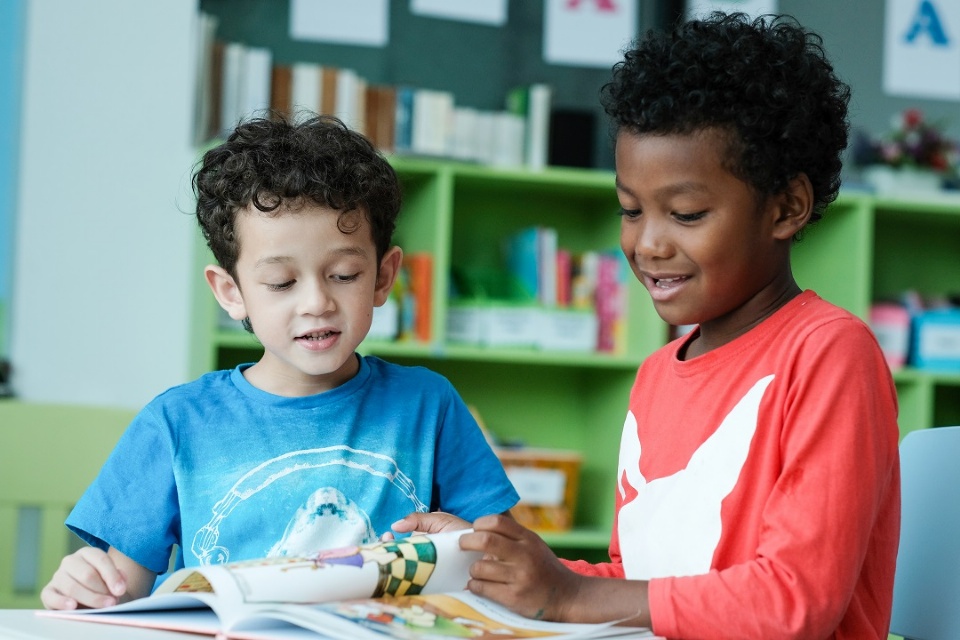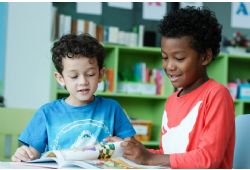It’s common knowledge that books promote literacy. And since children’s literature cultivates a host of skill sets when it comes to reading and writing, its correlation to the English Language Arts curriculum is evident.
But the benefits of children’s literature extend well beyond this discipline and are in fact connected to all other subject areas. There are many ways in which preschool and primary school educators can make children's literature an integral part of their classroom activities, and the unifying theme is diversity.First of all, educators should offer a comprehensive and diverse collection of books in their classroom. They can purchase books through the school budget, shop at used library or community book sales, or they can borrow books from school or public libraries. The goal is to maintain and grow a collection of varied books, from classics to contemporary titles.This collection of books should represent the heart of the classroom and serve as a springboard for lessons. Teacher read-alouds are a vital part of literacy instruction in the classroom. Story time activities serve as entertainment and as a way for children to ignite their own imagination, but books are also vehicles to learning.In keeping with the theme of diversity, it’s essential for an educator’s book collection to include different genres. Fiction goes a long way to open one’s horizons, but nonfiction is now in its golden age within the publishing world. Many nonfiction books teach and convey information in non-didactic ways, and make learning fun and engaging.What’s more, most of these nonfiction titles directly connect to the curriculum. For example, there are books that relate to counting, patterns, and math, or books that illustrate science concepts. Educators can begin lessons on such topics by reading one of these books and proposing critical questions that ignite curiosity. Students can then investigate and answer these questions through hands-on experiments.In the same vein, many other genres of literature also speak to children, from poetry to graphic novels, which are becoming increasingly popular. It’s important to offer a vast selection to students since everyone has their own preferences.Another reason diversity is essential relates to social inclusion. Literature reflects life, and each child must be able to see themselves in some stories. Likewise, they should also be able to see others in the stories. It’s about understanding oneself in relation to the world, but also, developing the ability to see things from another’s perspective.It’s therefore critical for the book collection to include a variety of authors, especially those from traditionally silenced or marginalized backgrounds. The stories themselves should contain a diverse cast of characters that properly showcase the diversity of our world. This way, educators can address social issues like racism, prejudice and immigration with more authenticity. Moreover, these stories introduce and expose children to different cultures and customs. They connect to various disciplines such as History, Geography and Ethics and Religious Culture.In short, children’s literature empowers children and encourages their academic development. And when that literature is rooted in diversity, it also provides valuable lessons about identity and social issues.
 In The Latest Issue:Latest Issue:
In The Latest Issue:Latest Issue:
- A Bittersweet Farewell
- The new Laval Aquatic Co...
- The End of an Era:
Articles
Calendar
Virtual- ANNUAL TEACHER APPRECIATION CONTEST
- APPUI LAVAL
- ARTS & CULTURE
- CAMPS
- CAR GUIDE
- CCIL
- CENTENNIAL ACADEMY
- CHARITY FUNDRAISING
- CITYTV
- COSMODÔME
- COMMUNITY CONNECTIONS
- COVER STORY
- DINA DIMITRATOS
- ÉCOLE SUPÉRIEURE DE BALLET DU QUÉBEC
- EDITORIALS
- ÉDUCALOI
- EDUCATION
- EMPLOYMENT & ENTREPRENEURSHIP
- FÊTE DE LA FAMILLE
- FÊTE DU QUARTIER SAINT-BRUNO
- FAMILIES
- FESTIVAL LAVAL LAUGHS
- FÊTE DE QUARTIER VAL-DES-BRISES
- FINANCES
- GLI CUMBARE
- GROUPE RENO-EXPERT
- HEALTH & WELL-BEING
- 30 MINUTE HIT
- ANXIETY
- CHILDREN`S HEALTH & WELLNESS
- CLOSE AID
- DENTAL WELLNESS
- EXTREME EVOLUTION SPORTS CENTRE
- FONDATION CITÉ DE LA SANTÉ
- GENERAL
- HEARING HEALTH
- MESSAGES FROM THE HEALTH AGENCY OF CANADA
- MENTAL HEALTH
- SEXUALITY
- SOCIAL INTEGRATION
- SPECIAL NEEDS
- TEENS
- THE NUTRITION CORNER
- THE NUTRITION CORNER - RECIPES
- VACATION DESTINATION
- WOMEN'S FITNESS
- WOMEN'S HEALTH
- HILTON MONTREAL/LAVAL
- HOME & GARDEN
- INTERNATIONAL WOMEN'S DAY
- JAGUAR LAVAL
- LAVAL À VÉLO
- LAVAL FAMILIES TV SHOW
- LAVAL FAMILIES MAGAZINE CARES
- LAVAL URBAN IN NATURE
- LE PARCOURS DES HÉROS
- LES PETITS GOURMETS DANS MA COUR
- LEON'S FURNITURE
- LEONARDO DA VINCI CENTRE
- LFM PREMIERES
- LIFE BALANCE
- M.P. PROFILE
- MISS EDGAR'S AND MISS CRAMP'S SCHOOL
- MISSING CHILDREN'S NETWORK
- NETFOLIE
- NORTH STAR ACADEMY LAVAL
- OUTFRONT MEDIA
- PASSION SOCCER
- PARC DE LA RIVIÈRE-DES-MILLE-ÎLES
- PÂTISSERIE ST-MARTIN
- PIZZERIA LÌOLÀ
- PLACE BELL
- PORTRAITS OF YOUR MNA'S
- ROCKET DE LAVAL
- SACRED HEART SCHOOL
- SCOTIA BANK
- SHERATON LAVAL HOTEL
- SOCIÉTÉ ALZHEIMER LAVAL
- STATION 55
- STL
- SUBARU DE LAVAL
- TECHNOLOGY
- TEDXLAVAL
- TODAY`S LAURENTIANS AND LANAUDIÈRE
- TODAY`S LAVAL
- WARNER MUSIC
- THIS ISSUE
- MOST RECENT
Magazine
Articles ~e 105,7 Rythme FM 4 chemins Annual Teacher Appreciation Contest Appui Laval Arts & Culture Ballet Eddy Toussaint Camps THIS ISSUE MORE...
CONTESTS Enter our contests
CONTESTS Enter our contests
CALENDAR
Events & Activities
COMMUNITY Posts Events
PUBLICATIONS Our Magazine Family Resource Directory
LFM BUSINESS NETWORK Learn more
COUPONS Click to save!
COMMUNITY Posts Events
PUBLICATIONS Our Magazine Family Resource Directory
LFM BUSINESS NETWORK Learn more
COUPONS Click to save!
SUBSCRIPTIONS
Subscribe to the magazine
Un-Subscribe
E-NEWSLETTER Subscribe to our E-newsletter Un-Subscribe
WRITE FOR US Guidelines & Submissions
POLLS Vote today!
E-NEWSLETTER Subscribe to our E-newsletter Un-Subscribe
WRITE FOR US Guidelines & Submissions
POLLS Vote today!
ADVERTISERS
How to & Media guide
Pay your LFM invoice
SUGGESTIONS Reader's Survey Suggest a Listing
LFM About Us Our Mission Giving Back Contact Us
SUGGESTIONS Reader's Survey Suggest a Listing
LFM About Us Our Mission Giving Back Contact Us
 PICK-UP LOCATIONS
Get a copy of LFM!
PICK-UP LOCATIONS
Get a copy of LFM!
TERMS & CONDITIONS Privacy | Terms
ISSN (ONLINE) 2291-1677
ISSN (PRINT) 2291-1677
Website by ZENxDESIGN




 BY:
BY: 
Tweet
Share